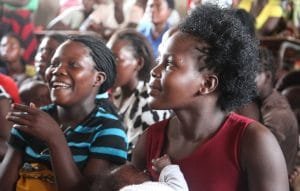
Women and adolescent girls
Sub-Saharan Africa, South Asia are epicentre of nutrition crisis among adolescent girls, women
By Gom Mirian
No fewer than 7. 6 million adolescent girls and women between the ages of 15 and 49 years old are reported to have been undernourished, putting women and newborn babies at risk.
The United Nations Children’s Fund (UNICEF) disclosed this in its recent global report issued on Tuesday in Abuja.
According to the report, this figure has soared from 5.6 million in 2018 to 7.3 million in 2021 in Nigeria, which is among the 12 hardest hit countries by the global food and nutrition crisis.
The twelve countries according to the report include Afghanistan, Burkina Faso, Chad, Ethiopia, Kenya, Mali, Niger, Nigeria, Somalia, South Sudan, Sudan and Yemen represent the epicenter of a global nutrition crisis that has increased by recent impacts of COVID-19 and exacerbated by the war in Ukraine and ongoing drought, conflict, and instability in some countries.
According to UNICEF Executive Director Catherine Russell, “This nutrition crisis is pushing millions of mothers and their children into hunger and severe malnutrition.
“Without urgent action from the international community, the consequences could last for generations to come.”
The report observed that an unprecedented and comprehensive look at the state of adolescent girls and women’s nutrition globally showed more than one billion adolescent girls and women suffer from undernutrition (including underweight and short height), deficiencies in essential micronutrients, and anaemia, with devastating consequences for their lives and wellbeing.
In Nigeria, 55 per cent of adolescent girls and women suffer from anaemia while nearly half of Nigerian women of reproductive age do not consume the recommended diet of at least 5 out of 10 food groups (grains and tubers, pulses, nuts and seeds, dairy, meat, poultry and fish, eggs, dark green leafy vegetables, other vitamin A-rich fruits and vegetables, other vegetables and other fruits) according to the 2022 National Food Consumption and Micronutrient Survey.
“Inadequate nutrition during girls and women’s lives can lead to weakened immunity, poor cognitive development, and an increased risk of life-threatening complications – including during pregnancy and childbirth risking mother’s lives, also, with dangerous and irreversible consequences for their children’s survival, growth, learning, and future earning capacity.
“For example, in Nigeria, 12 million children under 5 are stunted, meaning they are too short for their age due to malnutrition. Of those, about half become stunted during pregnancy and the first six months of life, the 500-day period when a child is fully dependent on maternal nutrition, according to a new analysis in the report.
“To prevent undernutrition in children, we must also address malnutrition in adolescent girls and women,” Russell added.
According to the report, South Asia and Sub-Saharan Africa remain the epicentre of the nutrition crisis among adolescent girls and women, home to 2 in 3 adolescent girls and women suffering from underweight globally, and 3 in 5 adolescent girls and women with anaemia. Meanwhile, adolescent girls and women from the poorest households are twice as likely to suffer from being underweight as those from the wealthiest households.
Global crises continue to disproportionately disrupt women’s access to nutritious food. In 2021, there were 126 million more food insecure women than men, compared to 49 million more in 2019, more than doubling the gender gap of food insecurity.
In Nigeria, the 2022 Cadre Harmonise analysis published by the government shows that 17 million Nigerians are suffering from acute food insecurity, and this is likely to increase to 25 million in the lean season this year (FMARD, 2022)
Since last year, UNICEF has scaled up its efforts in the countries hardest hit by the global nutrition crisis, including Nigeria, with an acceleration plan to prevent, detect, and treat wasting in women and children.
The report calls for governments, development and humanitarian partners and donors, civil society organizations and development actors to transform food, health and social protection systems for adolescent girls and women by:
It recommends prioritising adolescent girls and women’s access to nutritious, safe and affordable diets, and protecting adolescent girls and women from ultra-processed foods through marketing restrictions, compulsory front-of-pack labelling and taxation.
Implementing policies and mandatory legal measures to expand large-scale food fortification of routinely consumed foods such as flour, cooking oil and salt to help reduce micronutrient deficiencies and anaemia in girls and women was another measure the report pitched for.
It also calls for ensuring adolescent girls and women in low- and middle-income countries have free access to essential nutrition services, both before and during pregnancy, and while breastfeeding, including ante-natal multiple micronutrient supplements.
Expanding access to social protection programmes for the most vulnerable adolescent girls and women, including cash transfers and vouchers to improve girls’ and women’s access to nutritious and diverse diets was a key recommendation of the report.
According to Cristian Munduate, UNICEF Nigeria Country Representative, “To ensure a better future for our children, we must prioritize the access of adolescent girls and women to nutritious food and essential nutrition services.
The nutrition crisis is deepening among them, and urgent action is needed from all partners including the government of Nigeria and the international community. We cannot afford to overlook this crisis, and we must work together to transform food, health and social protection systems for adolescent girls and women.”


